Tribal Representatives Speak out About UN Forest Proposal
Air Date: Week of June 5, 2009
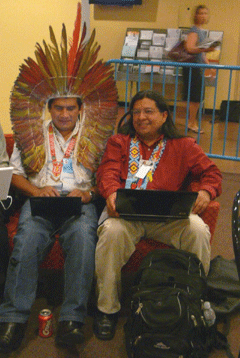
Egberto Tabo and Juan Carlos Jintach working in between REDD sessions. (Photo: Bruce Gellerman)
Representatives of indigenous groups from more than 70 countries meet at the United Nations in New York City. Top on their agenda is how a United Nations mechanism to reduce deforestation will affect native communities. Host Bruce Gellerman reports that the groups who depend most on intact forests might actually suffer from an international mechanism to preserve them.
Transcript
GELLERMAN: It’s Living on Earth, I’m Steve Curwood – and I’m Bruce Gellerman.
GELLERMAN: REDD…spelled R-E-D-D …. is the new green.
REDD stands for Reducing Emissions from Deforestation and Degradation. It’s a UN proposal to mitigate climate change by preserving the world’s tropical forests.
CURWOOD: Tropical trees store vast amounts of carbon - but each year wide swaths of forests are cut down or burned, releasing more greenhouse gases into the environment than all the world’s cars, planes, and trucks combined.
GELLERMAN: That’s where REDD comes in. The idea seems simple: the fastest way to reduce large scale emissions of CO2 is to protect forests, and the cheapest way to do that is to put a price on the trees so they’re more valuable left standing - preserving the carbon - than if they’re cut down.
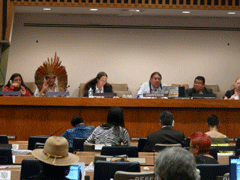
Tribal leaders meet at the United Nations. (Photo: Bruce Gellerman)
CURWOOD: Simple in principle, perhaps, but putting REDD into practice and making it part of the treaty this December at the UN climate negotiations in Copenhagen, will be difficult.
GELLERMAN: That’s because climate change is a hellishly complex issue - the devil is in the many REDD details that still have to be resolved. Janet Redman, of the environmental group Friends of the Earth, says one of the major problems is simply agreeing what is meant by: Reducing Emissions from Degradation and Deforestation.
REDMAN: There are so many different definitions of REDD. There’s no one legal definition at this point. There’s a definition from bilaterals, there’s a definition that international financial institutions have, there may be a UN definition soon, but at this point, we don’t even know what we’re talking about because there isn’t one concept that we’re all on the same page on.
[SOUNDS OF MEETING]
GELLERMAN: Forest protection was very much on the minds of delegates at the recent 8th UN Permanent Forum on Indigenous Issues, a ten day meeting held in a basement convention center at the United Nations building in New York City.
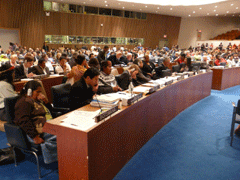
Indigenous representatives from more than 70 countries meet at the United Nations. (Photo: Bruce Gellerman)
[SOUNDS OF MEETING; SOMEONE COUGHING]
GELLERMAN: Hundreds of delegates from around the world gathered in a smoke-filled lobby, some wearing native clothes, feather headdresses, sarongs and animal skins, beads and hats, many hunched over laptops and held cell phones.
The place looked like a scene from Star Trek: a gathering of the global village. The talk was about avoiding deforestation and what that would mean for native peoples of the world...interpreters facilitated conversations but defining the REDD scheme can be culturally confounding says, Juan Carlos Jintiach of the Shuar tribe in Ecuador. Jintiach is Executive Co-director of Amazon Alliance, which represents more than a hundred rainforest organizations.
JINTIACH: If you bring this concept of REDD to the indigenous leaders they don’t know what you’re talking about. When we ask, what do you think about REDD - we’re talking this and this, so people say REDD is maybe red color or REDD may be something to do with fishing. So there’s no understanding this concept.
GELLERMAN: That’s not to say delegates at the Forum on Indigenous Issues didn’t realize what a REDD system could mean for them. Putting a price on carbon in trees to preserve the forest presents native people with a host of existential questions which they are largely powerless to answer. The Indigenous Forum is a high level body but it’s only advisory, so indigenous people have no real power at the United Nations climate talks, says Estabancio Castro Dias. He’s from Panama and the head of the International Alliance of Indigenous and Tribal Peoples of the Tropical Forests.
CASTRO DIAS: We believe that we haven’t been heard, because yes they give us a floor, but they give us a floor at the end of the day when all these delegates taking their papers and going out. So really it’s not taking into account what indigenous people saying and it’s not reflecting in the final paper of the negotiations.
GELLERMAN: Further complicating matters is a clash of cultures. The fundamental terms used to discuss REDD ---carbon trading – offsets and forest services, are alien concepts to many tribal and traditional people who speak of the Sacred Mother Earth.
Tom Goldtooth is head of the Minnesota-based Indigenous Environmental Network.
GOLDTOOTH: What’s happening is that in this whole market system is that it’s put a market value on traditional people and traditional teachings. Those things that we hold sacred to our people. This is evil at it’s worst. They’re trading air that is sacred. We’re looking at some spiritually profound values that people of industrial society really have a difficult time grasping. So when we talk about commodities – whether it’s the sacredness of trees, and especially air now – is in order to trade CO2, in order to trade greenhouse gases—this is air—is they have to define it as a property. It’s a property. Someone has to own the air in order to trade it. Very fundamental. So, the question is: who owns the air then?
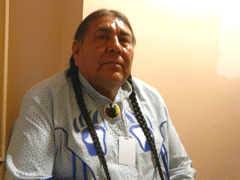
Tom Goldtooth is head of the Indigenous Environmental Network. (Photo: Bruce Gellerman)
GELLERMAN: And who owns the forests? And who gets the money that’s paid to preserve trees? Under a plan to pay to protect tropical forests ---billions –perhaps even trillions of dollars in carbon credits will be bought and sold. International lending organizations like the World Bank are playing a major role in developing the REDD mechanism.
[SOUNDS OF A PROTEST, CHANTING IN SPANISH]
But indigenous leaders denounced the organization’s human rights record. And during the UN Indigenous Forum protestors marched on Peru’s Consulate General.
[SOUNDS OF A PROTEST, CHANTING IN SPANISH]
GELLERMAN: The Peruvian government recently passed a law making it easier to buy land in the Amazon, land indigenous people of the forest say is theirs. Tribal members blocked oil pipelines, rivers and highways, demanding the law be changed. Peru’s president declared a state of emergency.
[TABU SPEAKING IN SPANISH]
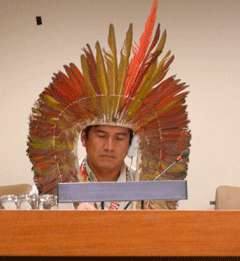
Egberto Tabo, president of the Coordination of Indigenous Organizations of the Cuenca Amazonia (COICA), leads a discussion at the United Nations. (Photo: Bruce Gellerman)
GELLERMAN: Egberto Tabu of Peru led the protest. He’s head of the Amazon Basin Indigenous People’s Organization. Tabu says he’s profoundly concerned about the proposed REDD forest plan because it threatens the indigenous peoples’ rights. As the market price for forests increases he warns, there will be a land grab - a green gold rush for the rights to possess the carbon locked in tropical trees.
[TABU SPEAKING SPANISH]
VOICEOVER: REDD is only made for corporations. We’re the landowners. We’re worried abut REDD. It’s not fair. We are the ones living in the jungle. We haven’t been taken into account in the design of REDD. Again, we will be the victims of the violation of the rights of indigenous people.
GELLERMAN: Two years ago, after two decades of debate, the United Nations Declaration on the Rights of Indigenous Peoples was adopted by 143 countries. The U.S. was one of just 4 nations that rejected it. Australia – another of the hold-outs - has since announced it will endorse the Declaration.
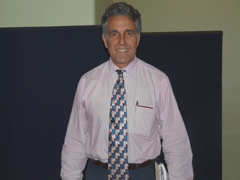
Charles McNeil from the United Nations Development Program. (Photo: Bruce Gellerman)
AND Charles McNeill from the UN Development Program says while the REDD forest deal may be flawed, slowly, things are changing.
MCNEILL: It’s true that they are not sitting around the table with governments in the UN Framework Convention on Climate Change; but what is encouraging is that the voice and impact and influence, I would say, of indigenous people has grown tremendously. It’s one of the most encouraging things I’ve seen, that every government, every donor, every NGO, every foundation working in this space is at least alluding to, referring to, talking the talk in terms of indigenous issues. Now, the issue is walking the talk and that’s where we’re about to embark ourselves.
GELLERMAN: In March, the UN body coordinating REDD negotiations granted indigenous people a voting seat on their panel where decision making is by consensus. Charles McNeill says despite the many challenges, a REDD method for preventing deforestation is the only way to rapidly stabilize global greenhouse gas emissions.

Egberto Tabo and Juan Carlos Jintach working in between REDD sessions. (Photo: Bruce Gellerman)
MCNEILL: If REDD weren’t so important I would have nothing to do with it because it’s so complex technically, politically, economically socially. But the only way out is through and to deal with REDD you’re going to have to deal with governance, you’re going to have to deal with poverty, you’re going to have to deal with human rights, equity, all the issues have to come to the fore to get this to work. As I say, it’s the most difficult challenging thing on Earth to be working on, and yet we can’t avoid it.
GELLERMAN: Indigenous leaders say industrial nations caused the climate crisis and before they’ll promise to go along with a REDD forest preservation scheme, developed countries will have to make deeper cuts in their greenhouse gas emissions.
But even if they do, Tom Goldtooth, Executive Director of U.S.-based Indigenous Environmental Network fears Reduction of Emissions from Deforestation and Degradation will turn native peoples into renters of their own land. Yet, he also believes climate change is real, and as icecaps melt and the oceans rise, we have only one option.
GOLDTOOTH: We’re in this dilemma as indigenous peoples but we’re not alone, we shouldn’t be alone in this. We have to stand together with all human beings, all two- legged people, because we’re in the boat together.
[MUSIC]
CURWOOD: For more information about forests and climate change and pictures of the UN Permanent Forum on Indigenous Issues, check out our web page: loe.org
[MUSIC]
Links
United Nations Permanent Forum on Indigenous Issues
International Alliance of Indigenous and Tribal Peoples of Tropical Forests
Indigenous Environmental Network
Coordinator of the Indigenous Organizations of the Amazonian River Basin
Living on Earth wants to hear from you!
Living on Earth
62 Calef Highway, Suite 212
Lee, NH 03861
Telephone: 617-287-4121
E-mail: comments@loe.org
Newsletter [Click here]
Donate to Living on Earth!
Living on Earth is an independent media program and relies entirely on contributions from listeners and institutions supporting public service. Please donate now to preserve an independent environmental voice.
NewsletterLiving on Earth offers a weekly delivery of the show's rundown to your mailbox. Sign up for our newsletter today!
 Sailors For The Sea: Be the change you want to sea.
Sailors For The Sea: Be the change you want to sea.
 The Grantham Foundation for the Protection of the Environment: Committed to protecting and improving the health of the global environment.
The Grantham Foundation for the Protection of the Environment: Committed to protecting and improving the health of the global environment.
 Contribute to Living on Earth and receive, as our gift to you, an archival print of one of Mark Seth Lender's extraordinary wildlife photographs. Follow the link to see Mark's current collection of photographs.
Contribute to Living on Earth and receive, as our gift to you, an archival print of one of Mark Seth Lender's extraordinary wildlife photographs. Follow the link to see Mark's current collection of photographs.
 Buy a signed copy of Mark Seth Lender's book Smeagull the Seagull & support Living on Earth
Buy a signed copy of Mark Seth Lender's book Smeagull the Seagull & support Living on Earth

